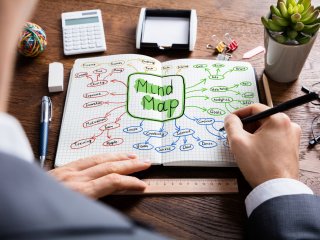Posted August 23rd, 2017
By Kris Powers
A mind map is a free-form way of organizing long lists of information and can be a fun and creative way to show relationships between thoughts and ideas. Simply put, a mind map is a diagram that literally “maps out” your ideas by connecting your thoughts to a central subject.
Starting with a single concept or idea; an image, word or phrase is usually drawn in the center of a blank page. Related images, graphics, symbols and words related to that concept are added – radiating out from the central idea. Those ideas that are biggest, or closest to the original concept, are connected directly to the center; other ideas branch out from those – like branches on a tree.
Lifehacker.com points out that among the many benefits to mind mapping is that “Mind maps link and group concepts together through natural associations. This helps generate more ideas, find deeper meaning in your subject, and also prompt you to fill in more or find what you're missing.”
One of the cool things about using the mind mapping technique is that it allows you to put down your thoughts in any order – and lets you organize them later. Mind mapping mimics the natural way our thoughts flow; one bouncing off another, random insights appearing here and there. To me, mind mapping is reminiscent of “free writing” exercises, the stream-of conscious writing that relaxes your thinking mind and lets your subconscious take over.
Utilizing mind maps can help you release your creative tendencies and can even help improve recall of important facts and information!
Having a tough time picturing what a mind map might look like? The site MindMapping.com offers this helpful tip: “One simple way to understand a Mind Map is by comparing it to a map of a city. The city center represents the main idea; the main roads leading from the center represent the key thoughts in your thinking process; the secondary roads or branches represent your secondary thoughts, and so on. Special images or shapes can represent landmarks of interest or particularly relevant ideas.”
Five Essential Characteristics of Mind Mapping (adapted from Mindmapping.com):
- The main idea, subject or focus is captured in a central image on the page
- Sub-topics or related ideas radiate from the central image as “branches”
- Written on those branches are single words, images or short phrases to record key thoughts
- Greater levels of details are captured on additional branches
- Topics of lesser importance are represented as “twigs” of the relevant branch and so forth
Mind maps can be used for almost any task - from studying coursework, planning your career or for mapping out any life change you may be contemplating (big or small). Mind mapping can be done with pen and paper, or there are many sites that offer software programs to help you out. Whatever form you choose, try it the next time you need to organize your thoughts. Once you start mind mapping, you’ll see that the uses are endless.
Tap into your natural creative state and get started today!
Ed4Career has valuable resources built into our programs and curriculum to help ensure student success. We have skilled Educational Consultants on staff, and we offer an Online Student Center as well as Career Coaching as a part of our program. Visit us today to learn more about the Ed4Career difference!





